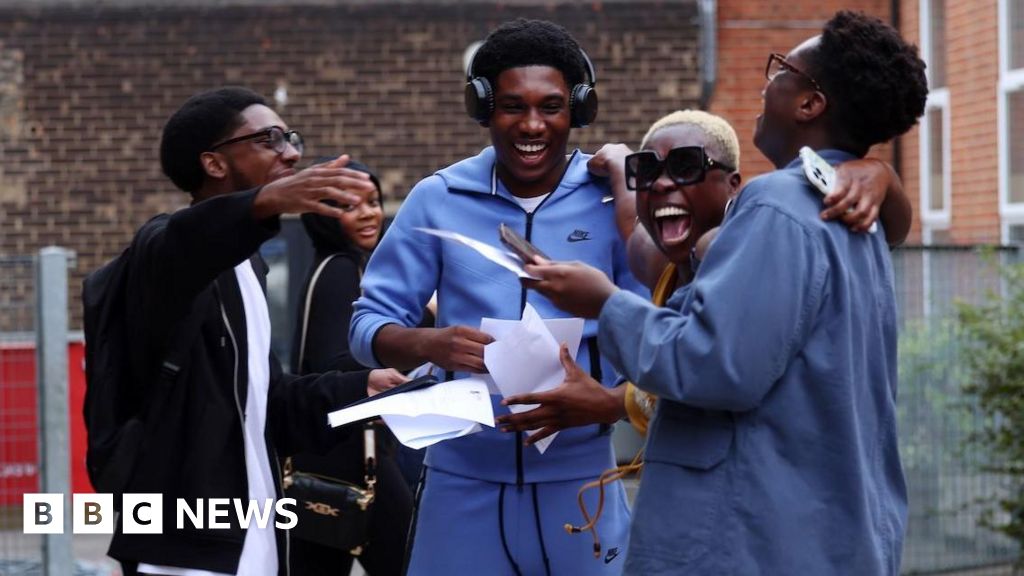Five key takeaways from 2025s A-level results
- BBC News
Before we get into the details of this years Level 3 exam results, there are two useful things to understand.
First, the legacy of Covid still looms - and in quite a unique way for these Year 13s.
Exam results spiked in 2020 and 2021 when exams were cancelled and grades were based on teachers assessments.
Most students getting results today were in Year 8 when all that started. By the time they were in Year 11, a phased effort to bring grades back down had reached its final stage in England.
The result? Their GCSE results were lower, and fewer met the mark to start A-level courses. It means this cohort of A-level students is seen, in the words of Ofquals chief regulator, as "smaller" but "stronger".
The second thing to understand is that universities are worried about their finances.
There has been a fall in the number of international students - who pay higher fees - coming to UK universities, due in part to changes to visa rules last year.
The chief executive of the Universities and Colleges Admissions Service (Ucas) said universities were keen to enrol UK undergraduates this year because they offered "stability" for "financial planning".
Here is everything you need to know about what has been a huge day for teenagers across the country.
Top A-level results have risen again – with 28.3% of all grades across England, Wales and Northern Ireland marked at A* or A.
Thats up from 27.8% last year.
The percentage of top grades rose from 27.6% to 28.2% in England, and from 30.3% to 30.4% in Northern Ireland.
Wales is the only nation to have seen a drop - from 29.9% to 29.5%.
This is the second year that grading has returned to pre-pandemic standards across all three nations, so overall results were always expected to be similar to last year.
The gap between the highest- and lowest-performing regions in England has grown again.
In London, 32.1% of A-level grades were marked at A* or A. In the North East, its 22.9%.
Thats a 9.2 percentage point gap – up from 8.8 last year, when the East Midlands was the lowest-performing region.
The North East and the West Midlands are the only regions to see falls in the proportion of top grades this year.
And the North East is the only region where that proportion is lower than both 2024 and 2019 - the last year that exams were sat before the Covid pandemic.
We dont have breakdowns of grades by ethnicity or free school meal status right now - that comes later in the year - but Education Secretary Bridget Phillipson said that "too often, opportunities depend on background rather than talent".
"The entrenched divide in outcomes seen over the last few years and the lack of progress for children from white working-class backgrounds is particularly concerning," she said.
Henri Murison, chief executive of the Northern Powerhouse Partnership, said there were "significant and deep-seated regional disparities".
"The pandemic has had long-lasting consequences and the grades our young people are using to apply for the most competitive university or apprenticeship places remain lower than those in regions such as London," he said.
A record number of 18-year-olds secured a place at their first choice of university.
Overall, 82% of offer-holders woke up to the news that they had successfully got into their first choice.
Thats the same proportion as last year, but there are more 18-year-olds this year.
So 226,580 got into their first, or "firm", choice – up from 216,750 last year.
Whats especially interesting is which universities theyre going to.
Ucas says acceptances were up across the board at all types of university, but the steepest growth was in acceptances to what it calls "higher tariff" universities - the most selective institutions, like those in the Russell Group.
The number of 18-year-olds from the UK accepted by these universities grew by 7.2%. And admissions teams still have places - the Russell Group itself said this morning that many of its members had courses available in Clearing.
Taking on more UK students may offer some financial stability for those selective universities.
But, with four in 10 universities thought to be in deficit and acceptances only up by 1.4% at "lower tariff" universities, there will be institutions hoping to recruit more students through Clearing.
Boys have outperformed girls at A-level for the first time since 2018.
Of boys grades, 28.4% were awarded an A* or A – compared to 28.2% of girls grades.
So boys have a 0.2 percentage point lead. Thats a switch from last year, when they were 0.4 percentage points behind girls.
Some of this could be down to whats been going on across individual subjects.
For example, boys increased their lead over girls in maths - the most popular A-level subject with more than 100,000 entries.
Boys performance in maths improved very slightly this year (from 42.5% of entries being marked A* or A last year to 42.6% this year), whereas girls dipped (from 41.2% last year to 40.2% this year).
However, girls still outperformed boys in more subjects.
Fewer students took A-levels this year, but theres been another increase in the number taking T-levels in England.
T-levels were first introduced in September 2020 and this is the fourth year of results. More schools and colleges are offering them, and there are more T-level courses to choose from.
A total of 11,909 students received T-level grades today – up from 7,435 last year.
The dropout rate remains high, though – and some students take longer than the standard two-years to complete the course.
11,724 students getting T-levels today started their course two years ago. Thats 72.9% of the total 16,081 students who started the course. The pass rate was 91.4%. Thats similar to last year, when it was 91.6%.
Additional reporting by Phil Leake, Libby Rogers, Muskeen Liddar and Rob England